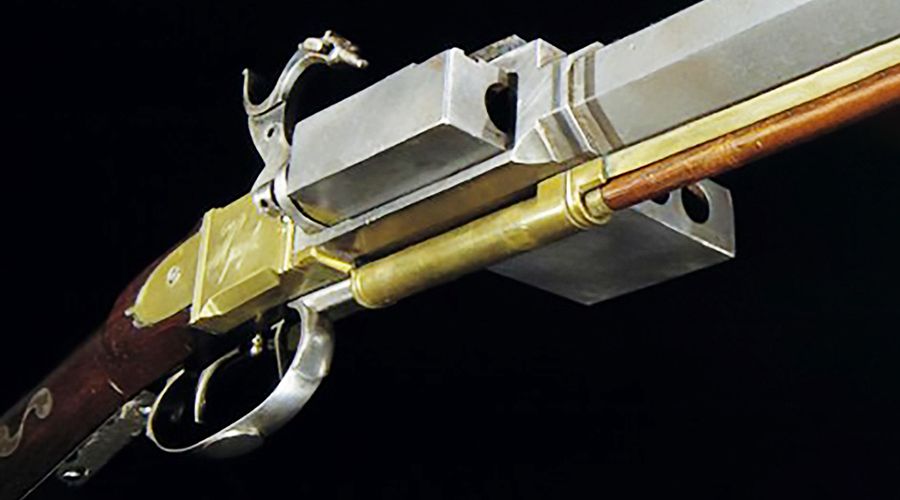You don’t get timeless designs in firearm engineering like the revolver and the repeating carbine rifle without a few memorable mishaps or welcome surprises along the way. The historical evolution of the technology behind the most popular firearms didn’t happen overnight and the process brought with it just about every variation you could think of…and some you couldn’t even imagine. One such design is inspired by the wind instrument made popular in blues, country and folk music, the French harp also known as: the harmonica.
The harmonica gun is a well-studied design that made its way into the frontiers at the turn of the 1840’s but its origins can be traced back a century prior to the 1740’s. It operates exactly how it sounds, no pun intended, with a steel slide in the breach moving horizontally in succession to feed the firearm. From Swiss inventors and French popularity to even the involvement of Jonathan Browning, the harmonica gun enjoyed a brief surgance in usage before it’s inevitable downfall thanks to competition from far less unwieldy weapons.
It might be a wonder of engineering and curious to see in action, but it didn’t stand a chance up next to the classic six shooters and repeating carbines that set the stage for future advancements. Even so, it proved to be one of those stories in history that shows our willingness to push boundaries even when it doesn’t completely work out and that’s gotta count for something…right?
A History to Remember
It was a cumbersome and meticulous firearm, one that was undoubtedly innovative but also rather questionable to say the least. Imagine the tales of the Oregon trail and the potentials of the wild west had the harmonica gun been the primary choice of weapon. Its impact from the tide of battle to the act of self defense would have altered the course of history and it’s that very scenario that holds our interest today. The harmonica gun arrived at a pivotal moment in the history of the United States, and looking back now, it gives insight into what could have been.
The harmonica gun was in production long enough to have been expanded on as well. After its rise there were patents filed in 1837 by Elijah Fisher and Dexter H. Chamberlain for a percussion cap harmonica gun and in 1854 by Alexander Bain for a pump action harmonica gun before a crank-operated version was patented in 1856 by C.G. Terrel. These variations showed the usefulness of the design across different platforms despite the clunky operations. The “rounds” in the slide often had to be individually loaded, making it a burden to carry even before you were ready to shoot. But there was opportunity in the demand for technological advancements in firearms and the harmonica gun seemed determined to take advantage of it. Even Sam Houston himself was armed with a harmonica rifle, and you can see it yourself at the National Museum of American History.
Would You Shoot One?
The footprint of the harmonica gun can actually be found in the decades to come if you know where to look, but it just couldn’t stand the test of time like some of its immediate competition and advancements to come like the 1911 platform. Outsmarted and certainly outgunned, the harmonica gun now resides mostly in museums and think pieces not unlike this one here, exploring the significance of innovation no matter the consequence and the unforeseen opportunities that are born of it. Even the wild west itself was a period of tradition clashing with invention, so it doesn’t necessarily come as surprising that there would be just a few rather outlandish ideas that somehow became reality.
There are countless stories of ingenuity in firearms ranging from genuinely impressive to downright hilarious, but the harmonica gun found itself at an interesting turning point where it was seemingly destined to be lost to history. Luckily, historians and enthusiasts alike have kept the harmonica gun alive and there are even some who have tried to recreate the platform to demonstrate its use. This resonates as a testament to the creativity in the design and the sheer curiosity beyond the rise and fall of such a wildly different, yet overwhelmingly familiar firearm platform.
Sounding Off
It may be an easily forgettable story in the history of firearms, and it’s not a cautionary tale or even one that imparted a significant cultural shift. But the harmonica gun is a worthy advancement in an era of rapid progress that should be remembered. Plus, there is no denying that it presents some uniquely entertaining thought experiments — like what if Harry Callahan’s iconic “Go ahead, make my day.” line from Dirty Harry had been delivered behind a percussion cap harmonica gun rather than a 44-magnum revolver?
There’s simply no telling what could have been.















